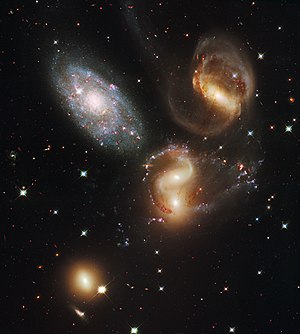| Stephan's Quintet | |
|---|---|
 | |
| Observation data (Epoch J2000) | |
| Constellation(s) | Pegasus |
| Right ascension | 22h 35m 57.5s[1] |
| Declination | +33° 57′ 36″[1] |
| Brightest member | NGC 7318B[1] |
| Number of galaxies | 5[1] |
| Other designations | |
| HCG 92, Arp 319, VV 288,[1] SQ[2] | |
Stephan's Quintet is a visual grouping of five galaxies of which four form the first compact galaxy group ever discovered.[2] The group, visible in the constellation Pegasus, was discovered by Édouard Stephan in 1877 at the Marseille Observatory.[3] The group is the most studied of all the compact galaxy groups.[2] The brightest member of the visual grouping (and the only non-member of the true group) is NGC 7320, which has extensive H II regions, identified as red blobs, where active star formation is occurring.
Four of the five galaxies in Stephan's Quintet form a physical association, a true galaxy group, Hickson Compact Group 92, and will likely merge with each other. Radio observations in the early 1970s revealed a filament of emission between the galaxies in the group. This same region is also detected in the faint glow of ionized atoms seen in the visible part of the spectrum as a green arc.
Space telescopes have provided new insight into the nature of the filament, which is now believed to be a shock-wave in the intergalactic gas, caused by one galaxy (NGC 7318B) falling into the center of the group at several million kilometres per hour.
Stephan's Quintet was selected as one of the five cosmic objects observed by the James Webb Space Telescope as part of the release of its first official science images.[4]
- ^ a b c d e "NASA/IPAC Extragalactic Database". Results for HCG 92. Retrieved 2006-09-18.
- ^ a b c Moles, M.; Marquez, I.; Sulentic, J. W. (1998). "The observational status of Stephan's Quintet". Astronomy and Astrophysics. 334: 473–481. arXiv:astro-ph/9802328. Bibcode:1998A&A...334..473M.
- ^ Stephan, M. E. (1877). "Nebulæ (new) discovered and observed at the observatory of Marseille, 1876 and 1877, M. Stephan". Monthly Notices of the Royal Astronomical Society. 37: 334–339. Bibcode:1877MNRAS..37..334S. doi:10.1093/mnras/37.6.334.
- ^ Garner, Rob (2022-07-08). "NASA Shares List of Cosmic Targets for Webb Telescope's 1st Images". NASA. Retrieved 2022-07-08.